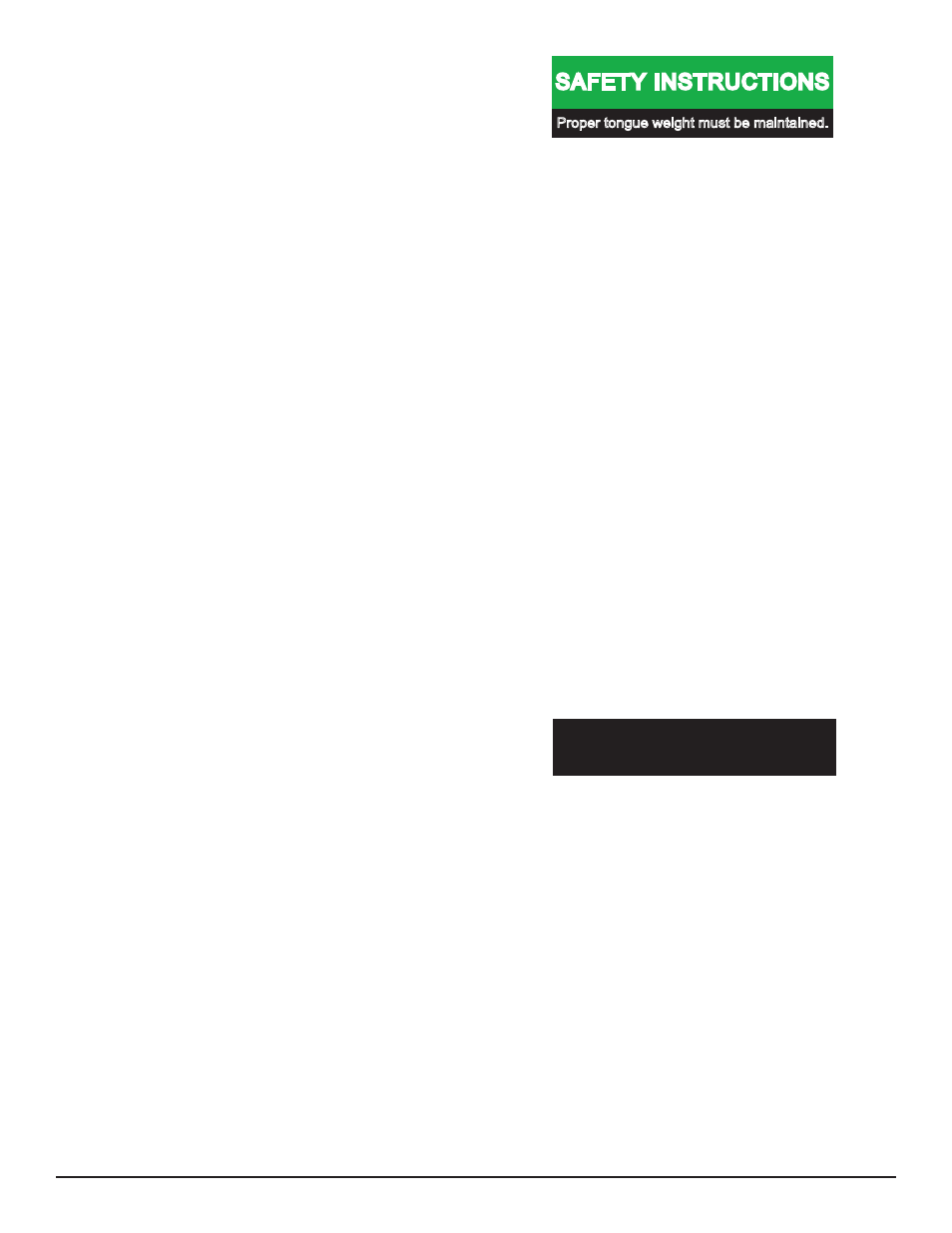Safety instructions – ShoreLand'r PT1720 V.1 User Manual
Page 9

Midwest Industries, Inc.
Ida Grove, IA 51445
800.859.3028
www.shorelandr.com
0004034
Page 9
Rev C 05/13/2010
Refer to your ShoreLand’r Owner’s
Guide and other decals on trailer for
additional information.
SAFETY INSTRUCTIONS
4810709
Proper tongue weight must be maintained.
Rev C 8/28/06
Before towing, check the following to ensure
that:
1. All parts, bolts, nuts and wheel lug
nuts are tight.
2. All wheel lug nuts must be tightened
to a minimum torque rating of 85 ft/lb.
3. Lug nuts must be re-torqued after the
first 50 miles, then periodically there
after.
4. Tires are inflated to manufacturer’s
standards. (See tire sidewall)
5. Wheel bearings have adequate
grease.
6. Hitch ball is the proper diameter and
has a rating equal to or greater than
the GVWR of the trailer.
7. Coupler is properly attached and
secured to coupler ball.
8. Trailer safety chains are crossed
under the tongue and attached to
towing vehicle.
9. All lights are operational. Note: It is
recommended that the trailer lights
be disconnected before backing into
the water.
10. Tie downs, winch strap and bow-
eye safety chain are secure.
11. Trailer tongue jack is in up or travel
position.
nuts. Note the three sets of holes in the very front of the bow stop
bracket. Place two of the three bolts in the top & bottom sets of
holes. The bolt in the top set of holes may be moved to the center
holes in the event that the bow stop needs to be adjusted higher.
This will have to be adjusted to meet the bow of the boat.
Attach the winch handle to the winch using the nylon locking nut
provided on the winch.
SPRINGS
Position the axle under the frame so it is properly orientated. All
axles have holes drilled for mounting brake lines. These attaching
holes must be positioned to the rear of the trailer.
Place the springs on the axle as shown so the closed eye of the
spring is to the front of the trailer. Drop two ½´x 2 9/16´x 6 1/2”
square U-bolts down over the spring clamp and over the springs
and on each side of the axle as shown.
Align the legs of the U-bolt with the holes in a spring pad and then
secure with ½” flange lock nuts. Tighten to keep all items in position
but do not securely tighten until the axle assembly is completely
installed under the frame.
AXLE
Place one of the spring bracket bushings into the rear of the spring
bracket and secure with a 9/16” x 3 1/4” hex bolt and hex lock nut.
Repeat in other spring bracket. Position the axle under the frame,
then hook the loop end of the spring around the bushings just in-
stalled. Note that if the axle is positioned too low when trying to
hook, the loops will not hook around the bushings.
Raise the front of the springs up so they align with the front hole
of the spring bracket. Secure in place with 9/16” X 3-1/4” hex bolts
and lock nuts. Repeat this process on the other spring.
Tighten all axle U-bolts and spring bolts not tightened at this time.
TIRE AND WHEEL ASSEMBLIES
Mount the tire and wheel assemblies using the ½” fine threaded
tapered lug nuts provided. Tighten to 85-95 ft/lb. of torque using the
rotation pattern as shown in the ShoreLandr’s Owners Manual.
Re-torque the lug nuts after 50 miles of driving and then periodi-
cally thereafter.
ADJUSTING INSTRUCTIONS
Place the pontoon on the trailer so that the pontoon tubes are flush
with the ends of the bunks. This will give you maximum support.
The bunk spacing has already been determined and set for width
when the trailer was assembled.
WINCH POST
With the pontoon in its proper position, slide the winch post as-
sembly backward until it contacts the deck. The plastic stops allow
for the variance in most deck heights. It is adjustable up or down
if required. This is accomplished by loosening the three bolts that
attach the top winch post assembly to the winch base.
Once the winch post is contacting the deck, tighten in position.
Hook the winch strap into the bow eye and tighten by cranking the
winch.
AXLE ADJUSTMENT
The amount of tongue weight on your trailer can be adjusted as
follows:
To lower the tongue weight, adjust the axle assembly forward. To
increase the tongue weight, adjust the axle assembly backward.
The distance that the axle assembly has to be moved will vary be-
cause it is directly related to the weight and center of gravity of the
boat placed on it.
Best towing is achieved when the tongue weight is 5-7% of the total
gross load of the complete unit.
Recheck all fasteners on the complete trailer to make sure they are
all tight and ready for towing. All fasteners should be periodically
checked before towing.
See your ShoreLand’r Owner’s Guide for further technical infor-
mation regarding your trailer and its components.
